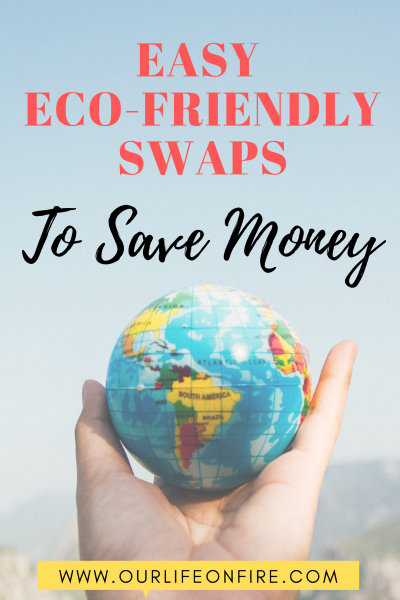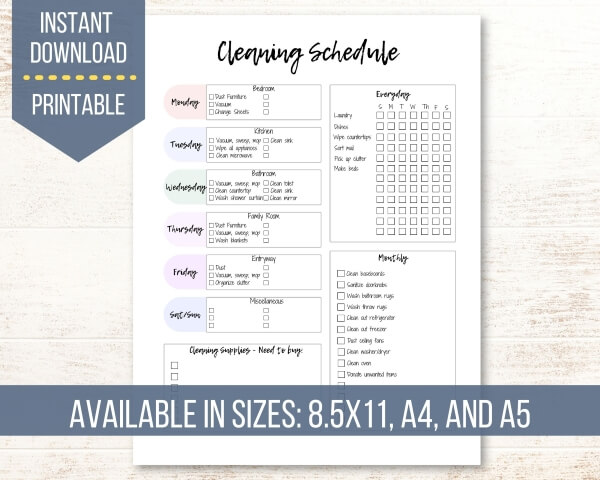
Easy Eco-Friendly Swaps To Reduce Waste & Save Money
Whether you want to save the environment or just save some money, making eco-friendly swaps for household items couldn’t be easier. There are so many simple ways that you can help to reduce waste and live more sustainably.
While doing your part to save the planet you will also be saving yourself some money in the long run. Purchasing eco-friendly items for your home may appear to be more costly, but these items are usually a one time purchase. Or they may last you a long time before they need to be replaced.
I have to admit that we have not converted to being completely green. But we do try to make conscious decisions on products that we buy and use in our home. We look for eco-friendly swaps and purchase them when we feel that they make sense for us. Over time we have found products that work well and can’t imagine going back to their environmentally unfriendly counterparts.
Eco-Friendly Swaps Are Simple and Cost Effective
If you are trying to live more sustainably or just want to make a few simple eco-friendly swaps, you will find that there are numerous options out there. Sometimes it takes a little bit of trial and error to find something that works for you. We are hoping to help you take the guesswork out of a few of those options.
Our Life On FIRE is a participant in the Amazon Services LLC Associates Program, an affiliate advertising program designed to provide a means for sites to earn advertising fees by advertising and linking to Amazon.com. As an Amazon Associate we earn from qualifying purchases at no additional cost to you.

REUSABLE GROCERY BAGS
Did you know that the average family in America takes home 1,500 plastic shopping bags per year and only 1% of those are recycled? That’s a lot of plastic bags that either end up polluting our waters or sitting in the landfill. The Center for Biological Diversity has a great list of 10 facts about single use plastics that might make you think twice the next time you are checking out at the store.
Purchasing reusable grocery bags is probably one of the easiest eco-friendly swaps. A lot of towns, counties, and states are now requiring the use of your own bags when shopping.
I was using reusable bags before it was even cool or mandatory. I first started using them in 2007 and believe it or not, I still have and use the exact same bags that I purchased at that time. The bags that I purchased and still currently use are Baggus.
Those of you who are completely green will probably not be happy with the fact that they are made out of nylon (please don’t send hate mail). But Baggu does use recycled materials to make their products. The company also has a recycling program where all of their bags can be returned to them to be recycled when possible or repurposed. And the fact that I have been using the same bags for 13+ years is pretty impressive. I can fully attest to their durability. They are also machine washable, hold 50lbs, and fold flat into a small pouch.
If you are looking for something that is more environmentally friendly, look for a bag that is made out of Cotton or Hemp. While material, manufacturing, and packaging may all be a factor in your decision on which bag to choose, I think it’s safe to say that any reusable bag is more environmentally friendly than the alternative – single use plastic or paper bags.
REUSABLE PRODUCE BAGS
The reusable produce bags that we use are made out of organic cotton mesh. They are great when purchasing produce as well as for storing them. The breathable fabric helps to keep your produce fresh longer versus keeping them in the plastic bags from the grocery store. They can easily be hand or machine washed. The produce bags are lightweight (the tare weight is listed on each bag). And the kind that we use have a wooden drawstring lock to hold everything in place (as seen in the picture on the left).
You can also check out the bags on the right which forgo the toggle and just use the string to cinch the bag. Either one would be a great option.
MICROFIBER CLOTHS
Microfiber cloths are great to use as an alternative to paper towels. Not only are they reusable but this particular type of cloth can remove 99% of bacteria on surfaces without the use of any harmful cleaning products. You can just use water! Just like any fabric there are different levels of quality based on the number of fibers per square inch. The microfiber cloths made by E-cloth have 3.1 million fibers per square inch. They are good for up to 300 washes so they should last a long time.
DISHWASHING CLOTHS
Most Americans use that yucky blue sponge to wash their dishes. The sponge gets broken down and discolored over time. And let’s face it, it ends up looking a little bit sad after a week’s worth of use.
I would use it until it just couldn’t be used anymore (please tell me that I’m not the only one!). And yes, I would put it in the dishwasher to disinfect (when I remembered to) but it was still just kind of gross looking.
After years of using the standard sponge, I am happy to say that we have found an alternative that I love – a cleaning cloth. I say “cleaning cloth” because this cloth can be used for many other things besides just washing dishes but that is mostly what we use it for. The Wet-It! Cloth is highly absorbent (holding up to 16x their weight in liquid) and will last for 6 months or more with normal use.
They are so soft and come in really great colorfast prints. The cloths can be washed in the washing machine, the dishwasher, microwave, or in a pot of boiling water – they are very easy to care for. Wet-It! cloths are also biodegradable and compostable – They break down in 6 weeks in a home compost and in 16 weeks in a commercial landfill.
Time to say goodbye to the sad blue sponge.
While perusing on Amazon, I also found these alternative cleaning cloths that are a little bit cheaper than the Wet It! brand. They have really pretty and fun prints and would be great to give as a gift. Or just a gift for yourself! I can’t attest to the brand or quality but if you buy them, let me know what you think.
Also, the one downfall of these types of cloths is that they do not have a scrubbing surface. So we use a different scrubbing cloth for those pots and pans that you need to put a little elbow grease into. We use these Skoy Scrubbers, which are not exactly green but eco-friendly since they will last a long time. You can put the scrubbing cloths in the dishwasher to be disinfected.
WOOL DRYER BALLS
We have been using wool dryer balls for years and have no complaints about them. Standard dryer sheets are full of chemicals and can leave residue on your clothes, your skin, and on your dryer. They also give off hazardous air pollutants. One of the simplest eco-friendly swaps that you can do is to use wool dryer balls. Wool dryer balls will shorten the drying time which saves on energy costs. They are reusable and should last 1,000+ loads (typically 2-4 years).
Another easy solution to reduce energy costs is to use a drying rack. Most of us in this day and age will not be hanging our clothes out on a clothesline. But a drying rack is a great alternative.
HOMEMADE CLEANERS
There are many resources online to make your own cleaners. Homemade cleaners are used in our home daily. We feel good about our choice to avoid the multitude of chemicals that are found in most store bought products. We store our cleaner in glass spray bottles.
Our daily homemade all purpose cleaner recipe:
- 1 cup of distilled water
- 1 teaspoon of unscented Castile Soap
It’s really that simple. This cleaner can be stored in the refrigerator and should be used within a week. Adding a preservative will also extend the cleaner’s shelf life and allow you to forgo storing it in the refrigerator.
Making your own cleaners can save you money. And once you have the “ingredients” it is easy and quick to make.
CLOTH NAPKINS
There is the obvious factor when choosing to use cloth napkins versus paper napkins – keeping more stuff out of the landfill. But it is not just the actual napkin that should be taken into consideration. It’s also the plastic packaging and the manufacturing process.
Besides the environmental factors, cloth napkins just feel better, work better, and are more durable. They are also more aesthetically pleasing than paper napkins. They can make sitting down to a regular meal at home feel a little more special.
BEESWAX FOOD WRAPS
Tired of fighting the plastic wrap? Well there’s an alternative: Beeswax Food Wraps.
The food wraps are made from beeswax, cotton, jojoba oil, and tree resin. They can be hand washed and air dried which makes them reusable. You can use these food wraps to cover the tops of bowls/containers, wrap a sandwich, and cover cut fruit and vegetables. They are also biodegradable.
Final Thoughts on Eco-Friendly Swaps For Your Home
These easy eco-friendly swaps are a great start to creating new environmentally friendly habits and intentions. Even if you only make one or two small changes in your life to improve our environment, it will make a huge difference over time. Working together to consume less and create less waste will be beneficial to everyone.
There are so many amazing places to visit in this world. We want to ensure that our children get to experience all of the natural beauty that exists. It is important to be mindful of our planet and to know that we can make choices to help retain it’s beauty.
Related Articles To Help You Save Money:
What you can do in 1 month to save money and transform your finances
Frugal living tips that make a big impact
How to save money and never pay full price again





















20 thoughts on “Easy Eco-Friendly Swaps To Reduce Waste & Save Money”
Great post! I don’t think people always realise that you can save money and be more sustainable too! Cheers
Thanks! And yes, I think people think that being more sustainable will cost more money because they don’t see the long term benefits. Thanks for reading!
Such a well thought out post! These are all good points, and sometimes we don’t stop to think about things that are already reusable like sponges or cleaning bottles.
Jason and Patti, I tried to send something on your contact page, but it looks like it’s not working. Please let me know how to reach you 🙂
Thank you for your kind words! I’m sorry to hear that our contact page was not working for you. I will have to look into that! You can email us at hello@ourlifeonfire.com. Looking forward to hearing from you.
Thanks for this list. I will be implementing some of these right away.
Great tips! We haven’t used paper towels for years but readily admit that our dish towels are looking rough and there are always a ton of towels and napkins in the wash. It was easier before kids but now I try to convince them to at least help fold!
Love the idea for replacing our nasty sponge for dishes. I’ll give the Wet-It Cloth a try. Thanks!
The Wet-It Cloth (or even similar cloths) and the scrubby sponge are my favorite things on the list to use. You should definitely give it a try!
Great ideas here! I use grocery and produce bags and feel like I’m much eco-friendlier now without all that plastic. However, paper towels is one thing I can’t seem to live without. I incorporated a reusable towel for half of the tasks, but still it’s just too convenient to easily let go…
I totally get what you are saying about paper towels – we have 2 little kids and sometimes I just want to use a paper towel for cleanup so that I can just throw it out! . We still buy them but only once or twice a year now. Instead we use the microfiber cloths for most of our cleaning. Or like you said, just a reusable towel works too!
I am definitely going to give the wool dryer balls a try! Any specific essential oils you recommend to go with it?
The wool dryer balls are so much better than dryer sheets! I don’t usually put EO on them. I have experimented with it and found that the scent doesn’t really stay and transfer onto your clothes. But I did recently read a recommendation to put EOs on the dryer ball towards the end of the cycle, which may work better but I have not tried it yet! Let me know if it works for you. Also, as far as scent goes, Lavender would be a great choice!
Wow, this is super helpful! I decided to start making changes and buy more reusable items, so this is great!
All of the small changes add up! Happy that I could give you a few more ideas on being more eco-friendly. Thanks for reading!
Great tips for being eco-friendly. I do some of these things but I will be using some more of these tips! Thanks!
Love that you found a few more ideas to add to your eco-friendly lifestyle. If you have any tips for us, let us know!
We’ve been trying to make more eco-conscious swaps so I love these ideas! Thanks for sharing!
There are so many simple ways for us to be more eco-conscious. Hope you found some new ideas from our post! Thanks for reading!
Thanks for this list – my husband and I are on a similar path to make more conscious decisions. How often do you wash the WetIt! cloths for dishes? Do you stick it in the dishwasher or wash in the washing machine every so often? We’ve been using a sponge and I would LOVE to start moving away from it. 🙂
I LOVE the Wet It! cloths! They are so soft and wash really well. I throw them in the washing machine about once or twice per week then let air dry (they can go in the dryer but shrink). I would also get a scrubbing sponge too though – the one that I recommend is great. You should definitely try them. I will never go back to a regular sponge again!